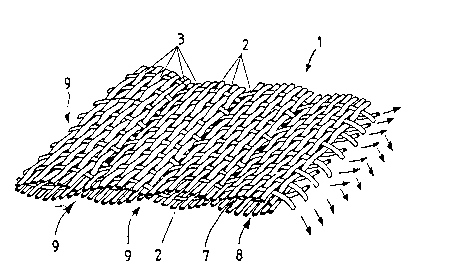Une partie des informations de ce site Web a été fournie par des sources externes. Le gouvernement du Canada n'assume aucune responsabilité concernant la précision, l'actualité ou la fiabilité des informations fournies par les sources externes. Les utilisateurs qui désirent employer cette information devraient consulter directement la source des informations. Le contenu fourni par les sources externes n'est pas assujetti aux exigences sur les langues officielles, la protection des renseignements personnels et l'accessibilité.
L'apparition de différences dans le texte et l'image des Revendications et de l'Abrégé dépend du moment auquel le document est publié. Les textes des Revendications et de l'Abrégé sont affichés :
| (12) Demande de brevet: | (11) CA 2116978 |
|---|---|
| (54) Titre français: | STRUCTURE EN FIBRE RENFORCEE PAR COLLAGE ET PROCEDE DE FABRICATION |
| (54) Titre anglais: | A METHOD FOR MANUFACTURING A LAMINATING REINFORCED FIBRE STRUCTURE AND A CORRESPONDING REINFORCED FIBRE STRUCTURE |
| Statut: | Réputée abandonnée et au-delà du délai pour le rétablissement - en attente de la réponse à l’avis de communication rejetée |
| (51) Classification internationale des brevets (CIB): |
|
|---|---|
| (72) Inventeurs : |
|
| (73) Titulaires : |
|
| (71) Demandeurs : |
|
| (74) Agent: | GOWLING WLG (CANADA) LLP |
| (74) Co-agent: | |
| (45) Délivré: | |
| (86) Date de dépôt PCT: | 1992-09-11 |
| (87) Mise à la disponibilité du public: | 1993-03-18 |
| Licence disponible: | S.O. |
| Cédé au domaine public: | S.O. |
| (25) Langue des documents déposés: | Anglais |
| Traité de coopération en matière de brevets (PCT): | Oui |
|---|---|
| (86) Numéro de la demande PCT: | PCT/FI1992/000241 |
| (87) Numéro de publication internationale PCT: | WO 1993005219 |
| (85) Entrée nationale: | 1994-03-03 |
| (30) Données de priorité de la demande: | |||||||||
|---|---|---|---|---|---|---|---|---|---|
|
2116978 9305219 PCTABS00020
The object of the invention is a method for manufacturing a
laminating reinforced fibre structure (1), in which fibre layers (7,
8) made of cross-woven warp or weft yarn bundles are manufactured
as a warp structure, these being tied together with ties (9) and
a filler (4) is placed in the channel formed by the layers one
top of each other and the ties. In accordance with the invention
two fiber layers (7, 8) one top of one another are woven together
in a manner that is as such known, in such a way that the warp (2)
or alternatively weft (3) bundles of yarns run in turn in the
upper and lower structures thus forming large channels in relation
to the size of the fabric and pieces impermeable to a binder
substance is used as a filler (4).
Note : Les revendications sont présentées dans la langue officielle dans laquelle elles ont été soumises.
Note : Les descriptions sont présentées dans la langue officielle dans laquelle elles ont été soumises.

2024-08-01 : Dans le cadre de la transition vers les Brevets de nouvelle génération (BNG), la base de données sur les brevets canadiens (BDBC) contient désormais un Historique d'événement plus détaillé, qui reproduit le Journal des événements de notre nouvelle solution interne.
Veuillez noter que les événements débutant par « Inactive : » se réfèrent à des événements qui ne sont plus utilisés dans notre nouvelle solution interne.
Pour une meilleure compréhension de l'état de la demande ou brevet qui figure sur cette page, la rubrique Mise en garde , et les descriptions de Brevet , Historique d'événement , Taxes périodiques et Historique des paiements devraient être consultées.
| Description | Date |
|---|---|
| Inactive : CIB de MCD | 2006-03-11 |
| Inactive : CIB de MCD | 2006-03-11 |
| Inactive : CIB de MCD | 2006-03-11 |
| Demande non rétablie avant l'échéance | 2000-09-11 |
| Le délai pour l'annulation est expiré | 2000-09-11 |
| Inactive : Abandon.-RE+surtaxe impayées-Corr envoyée | 1999-09-13 |
| Réputée abandonnée - omission de répondre à un avis sur les taxes pour le maintien en état | 1999-09-13 |
| Demande publiée (accessible au public) | 1993-03-18 |
| Date d'abandonnement | Raison | Date de rétablissement |
|---|---|---|
| 1999-09-13 |
Le dernier paiement a été reçu le 1998-08-28
Avis : Si le paiement en totalité n'a pas été reçu au plus tard à la date indiquée, une taxe supplémentaire peut être imposée, soit une des taxes suivantes :
Veuillez vous référer à la page web des taxes sur les brevets de l'OPIC pour voir tous les montants actuels des taxes.
| Type de taxes | Anniversaire | Échéance | Date payée |
|---|---|---|---|
| TM (demande, 5e anniv.) - petite | 05 | 1997-09-11 | 1997-08-12 |
| TM (demande, 6e anniv.) - petite | 06 | 1998-09-11 | 1998-08-28 |
Les titulaires actuels et antérieures au dossier sont affichés en ordre alphabétique.
| Titulaires actuels au dossier |
|---|
| FINNCLEVER OY |
| Titulaires antérieures au dossier |
|---|
| MAURI LAITINEN |